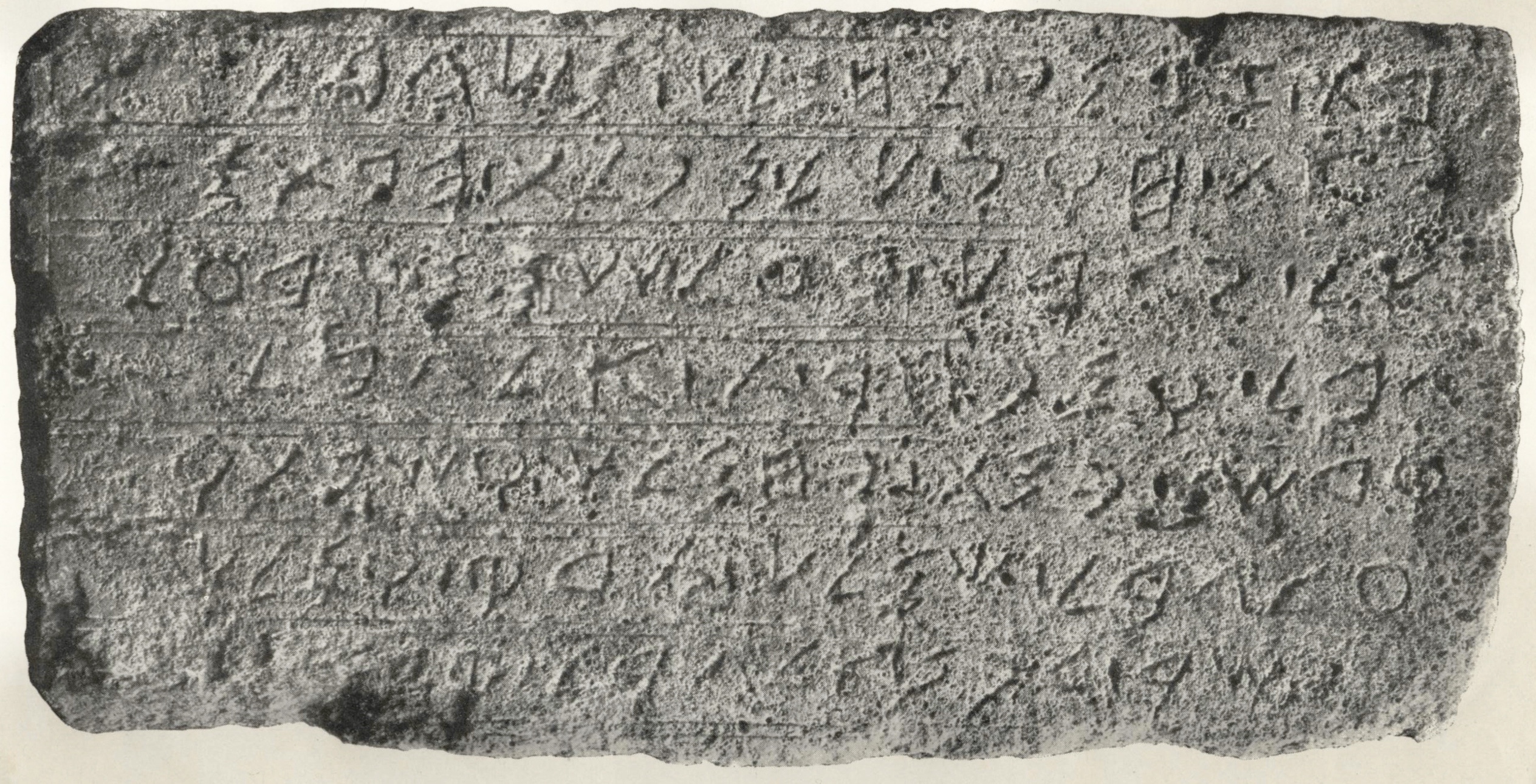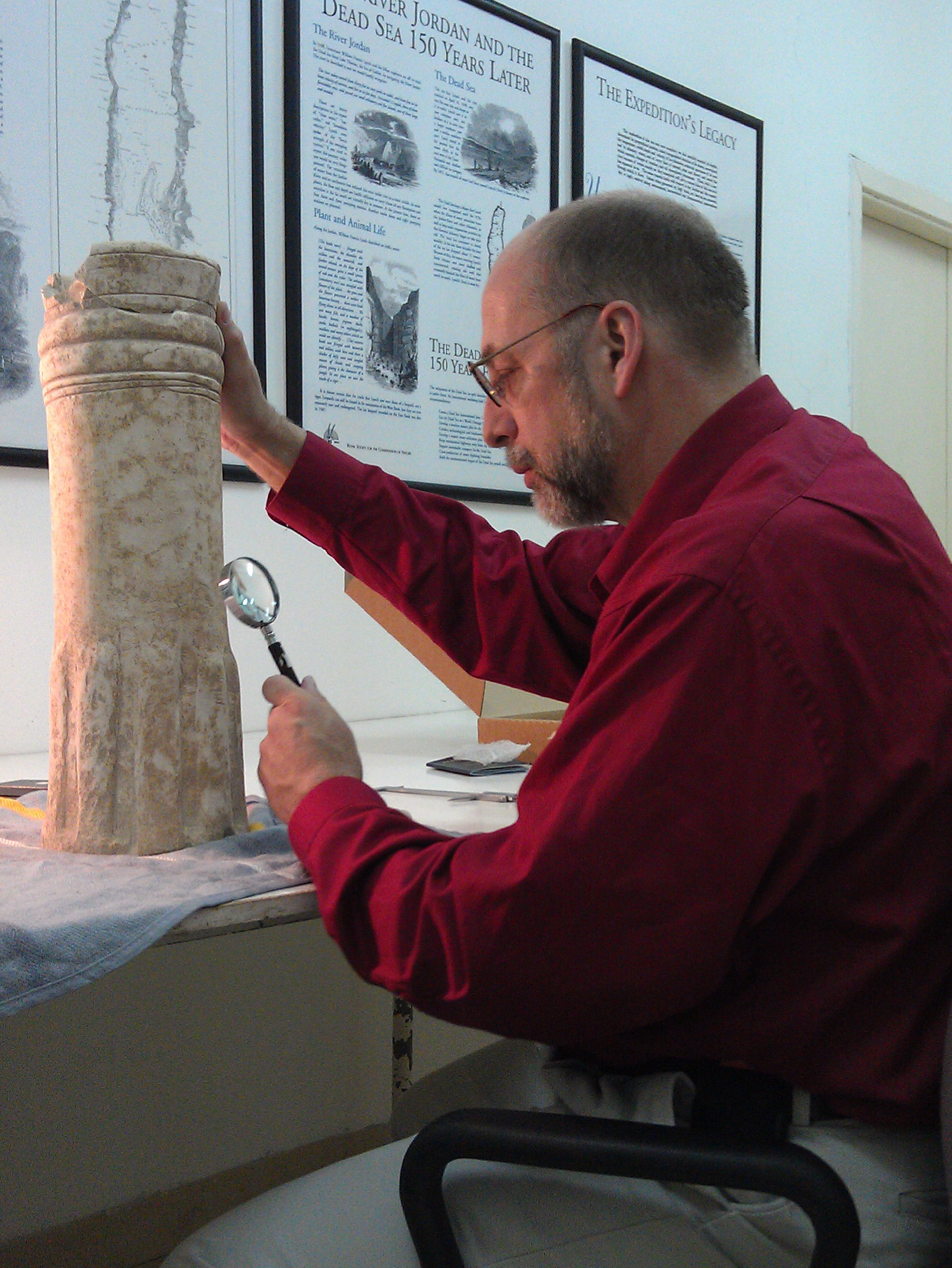|
Byblian Royal Inscriptions
The Byblian royal inscriptions are five inscriptions from Byblos written in an early type of Phoenician script, all of which were discovered in the early 20th century. They constitute the largest corpus of lengthy Phoenician inscriptions from the area of the "Phoenician homeland"; it is the only major site in the region which has been excavated to pre-Hellenistic levels. The five royal inscriptions * The Ahiram Sarcophagus (KAI 1), discovered in 1923, together with two fragments of alabaster vases with the name of Ramesses II Currently in the National Museum of Beirut. * The Yehimilk inscription (KAI 4) published in 1930. Currently in the museum of Byblos Castle. * The Abiba’l inscription (KAI 5), on a throne on which a statue of Sheshonq I was placed, found in 1895, published in 1903. Currently in the Vorderasiatisches Museum Berlin. * The Osorkon Bust or Eliba'l Inscription (KAI 6), inscribed on a statue of Osorkon I; known since 1881, published in 1925. Currently at the Lou ... [...More Info...] [...Related Items...] OR: [Wikipedia] [Google] [Baidu] |
Safatba'al Inscription
The Safatba'al inscription or the Shipitbaal inscription is a Phoenician inscription (KAI 7, TSSI III 9) found in Byblos in 1936, published in 1945. It is at the National Museum of Beirut. Text of the inscription The inscription reads: :: Bibliography * Christopher Rollston,The Dating of the Early Royal Byblian Phoenician Inscriptions: A Response to Benjamin Sass" ''MAARAV'' 15 (2008): 57–93. * Benjamin Mazar, The Phoenician Inscriptions from Byblos and the Evolution of the Phoenician-Hebrew Alphabet, in The Early Biblical Period: Historical Studies (S. Ahituv and B. A. Levine, eds., Jerusalem: IES, 1986 riginal publication: 1946: 231–247. * William F. Albright William Foxwell Albright (May 24, 1891– September 19, 1971) was an American archaeologist, biblical scholar, philologist, and expert on ceramics. He is considered "one of the twentieth century's most influential American biblical scholars." ..., The Phoenician Inscriptions of the Tenth Century B.C. from ... [...More Info...] [...Related Items...] OR: [Wikipedia] [Google] [Baidu] |
Phoenician Inscriptions
The Canaanite and Aramaic inscriptions, also known as Northwest Semitic inscriptions, are the primary extra-Biblical source for understanding of the society and history of the ancient Phoenicians, Hebrews and Arameans. Semitic inscriptions may occur on stone slabs, pottery ostraca, ornaments, and range from simple names to full texts. The older inscriptions form a Canaanite–Aramaic dialect continuum, exemplified by writings which scholars have struggled to fit into either category, such as the Stele of Zakkur and the Deir Alla Inscription. The Northwest Semitic languages are a language group that contains the Aramaic language, as well as the Canaanite languages including Phoenician and Hebrew. Languages The old Aramaic period (850 to 612 BC) saw the production and dispersal of inscriptions due to the rise of the Arameans as a major force in Ancient Near East. Their language was adopted as an international language of diplomacy, particularly during the late stages of the Ne ... [...More Info...] [...Related Items...] OR: [Wikipedia] [Google] [Baidu] |
8th-century BC Works
The 8th century is the period from 701 ( DCCI) through 800 ( DCCC) in accordance with the Julian Calendar. The coast of North Africa and the Iberian Peninsula quickly came under Islamic Arab domination. The westward expansion of the Umayyad Empire was famously halted at the siege of Constantinople by the Byzantine Empire and the Battle of Tours by the Franks. The tide of Arab conquest came to an end in the middle of the 8th century.Roberts, J., ''History of the World'', Penguin, 1994. In Europe, late in the century, the Vikings, seafaring peoples from Scandinavia, begin raiding the coasts of Europe and the Mediterranean, and go on to found several important Monarchy, kingdoms. In Asia, the Pala Empire is founded in Bengal. The Tang dynasty reaches its pinnacle under China, Chinese Emperor Xuanzong of Tang, Emperor Xuanzong. The Nara period begins in Japan. Events * Estimated century in which the poem Beowulf is composed. * Classical Maya civilization begins to decline. * ... [...More Info...] [...Related Items...] OR: [Wikipedia] [Google] [Baidu] |
9th-century BC Works
The 9th century was a period from 801 ( DCCCI) through 900 ( CM) in accordance with the Julian calendar. The Carolingian Renaissance and the Viking raids occurred within this period. In the Middle East, the House of Wisdom was founded in Abbasid Baghdad, attracting many scholars to the city. The field of algebra was founded by the Muslim polymath al-Khwarizmi. The most famous Islamic Scholar Ahmad ibn Hanbal was tortured and imprisoned by Abbasid official Ahmad ibn Abi Du'ad during the reign of Abbasid caliph al-Mu'tasim and caliph al-Wathiq. In Southeast Asia, the height of the Mataram Kingdom happened in this century, while Burma would see the establishment of the major kingdom of Pagan. Tang China started the century with the effective rule under Emperor Xianzong and ended the century with the Huang Chao rebellions. While the Maya experienced widespread political collapse in the central Maya region, resulting in internecine warfare, the abandonment of cities, and a northw ... [...More Info...] [...Related Items...] OR: [Wikipedia] [Google] [Baidu] |
10th-century BC Works
1 (one, unit, unity) is a number representing a single or the only entity. 1 is also a numerical digit and represents a single unit of counting or measurement. For example, a line segment of ''unit length'' is a line segment of length 1. In conventions of sign where zero is considered neither positive nor negative, 1 is the first and smallest positive integer. It is also sometimes considered the first of the infinite sequence of natural numbers, followed by 2, although by other definitions 1 is the second natural number, following 0. The fundamental mathematical property of 1 is to be a multiplicative identity, meaning that any number multiplied by 1 equals the same number. Most if not all properties of 1 can be deduced from this. In advanced mathematics, a multiplicative identity is often denoted 1, even if it is not a number. 1 is by convention not considered a prime number; this was not universally accepted until the mid-20th century. Additionally, 1 is the ... [...More Info...] [...Related Items...] OR: [Wikipedia] [Google] [Baidu] |
11th-century BC Works
The 11th century is the period from 1001 ( MI) through 1100 ( MC) in accordance with the Julian calendar, and the 1st century of the 2nd millennium. In the history of Europe, this period is considered the early part of the High Middle Ages. There was, after a brief ascendancy, a sudden decline of Byzantine power and a rise of Norman domination over much of Europe, along with the prominent role in Europe of notably influential popes. Christendom experienced a formal schism in this century which had been developing over previous centuries between the Latin West and Byzantine East, causing a split in its two largest denominations to this day: Roman Catholicism and Eastern Orthodoxy. In Song dynasty China and the classical Islamic world, this century marked the high point for both classical Chinese civilization, science and technology, and classical Islamic science, philosophy, technology and literature. Rival political factions at the Song dynasty court created strife amongs ... [...More Info...] [...Related Items...] OR: [Wikipedia] [Google] [Baidu] |
Byblian Royal Inscriptions
The Byblian royal inscriptions are five inscriptions from Byblos written in an early type of Phoenician script, all of which were discovered in the early 20th century. They constitute the largest corpus of lengthy Phoenician inscriptions from the area of the "Phoenician homeland"; it is the only major site in the region which has been excavated to pre-Hellenistic levels. The five royal inscriptions * The Ahiram Sarcophagus (KAI 1), discovered in 1923, together with two fragments of alabaster vases with the name of Ramesses II Currently in the National Museum of Beirut. * The Yehimilk inscription (KAI 4) published in 1930. Currently in the museum of Byblos Castle. * The Abiba’l inscription (KAI 5), on a throne on which a statue of Sheshonq I was placed, found in 1895, published in 1903. Currently in the Vorderasiatisches Museum Berlin. * The Osorkon Bust or Eliba'l Inscription (KAI 6), inscribed on a statue of Osorkon I; known since 1881, published in 1925. Currently at the Lou ... [...More Info...] [...Related Items...] OR: [Wikipedia] [Google] [Baidu] |
William F
William is a masculine given name of Norman French origin.Hanks, Hardcastle and Hodges, ''Oxford Dictionary of First Names'', Oxford University Press, 2nd edition, , p. 276. It became very popular in the English language after the Norman conquest of England in 1066,All Things William"Meaning & Origin of the Name"/ref> and remained so throughout the Middle Ages and into the modern era. It is sometimes abbreviated "Wm." Shortened familiar versions in English include Will, Wills, Willy, Willie, Liam, Bill, and Billy. A common Irish form is Liam. Scottish diminutives include Wull, Willie or Wullie (as in Oor Wullie or the play ''Douglas''). Female forms are Willa, Willemina, Wilma and Wilhelmina. Etymology William is related to the German given name ''Wilhelm''. Both ultimately descend from Proto-Germanic ''*Wiljahelmaz'', with a direct cognate also in the Old Norse name ''Vilhjalmr'' and a West Germanic borrowing into Medieval Latin ''Willelmus''. The Proto-Germa ... [...More Info...] [...Related Items...] OR: [Wikipedia] [Google] [Baidu] |
Benjamin Mazar
Benjamin Mazar ( he, בנימין מזר; born Binyamin Zeev Maisler, June 28, 1906 – September 9, 1995) was a pioneering Israeli historian, recognized as the "dean" of biblical archaeologists. He shared the national passion for the archaeology of Israel that also attracts considerable international interest due to the region's biblical links. He is known for his excavations at the most significant biblical site in Israel: south and south west of the Temple Mount in Jerusalem. In 1932 he conducted the first archaeological excavation under Jewish auspices in Israel at Beit She'arim (the largest catacombs ever found in Israel) and in 1948 was the first archaeologist to receive a permit granted by the new State of Israel ( Tell Qasile, 1948). Mazar was trained as an Assyriologist and was an expert on biblical history, authoring more than 100 publications on the subject. He developed the field of historical geography of Israel. For decades he served as the chairman of the Israe ... [...More Info...] [...Related Items...] OR: [Wikipedia] [Google] [Baidu] |
Christopher Rollston
Prof. Christopher A. Rollston (born in Michigan, United States) is a scholar of the ancient Near East, specializing in Hebrew Bible, Greek New Testament, Old Testament Apocrypha, Northwest Semitic literature, epigraphy and paleography. Biography Rollston holds an MA and Ph.D. from Johns Hopkins University Department of Near Eastern Studies. He also holds an MAR from Emmanuel School of Religion (now known as Emmanuel Christian Seminary), and an undergraduate degree from Great Lakes Christian College. Rollston is a member of the Phi Beta Kappa Society. He is Professor of Northwest Semitic Languages and Literatures at George Washington University and is chair of the department of Classical and Near Eastern Languages and Civilizations there. He has been a National Endowment for the Humanities Research Scholar at the Albright Institute of Archaeological Research in Jerusalem (Fall 2013) and also at the American Center of Oriental Research in Amman (Summer 2002). He was a Visiting P ... [...More Info...] [...Related Items...] OR: [Wikipedia] [Google] [Baidu] |





